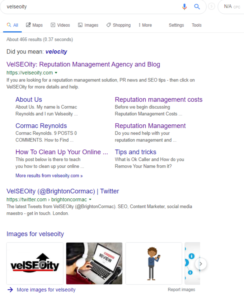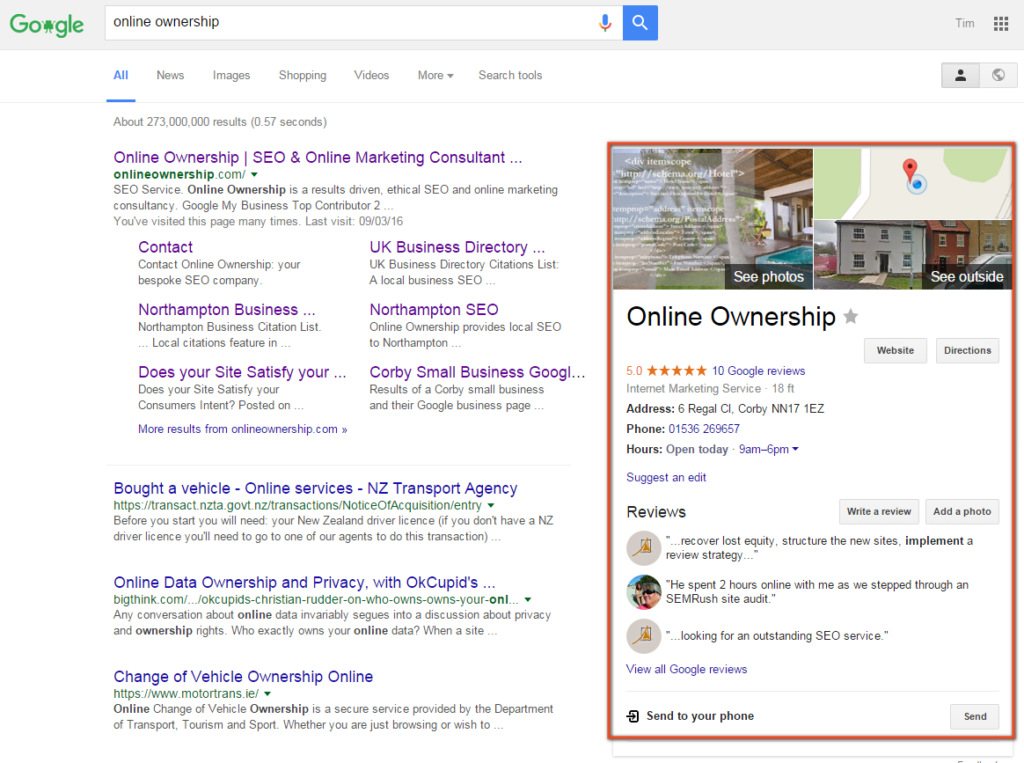Since every company is different, with different situations and challenges, the following is more of a framework other than a list of set-in-stone rules on how to deal with and push down negative search results on Google. Let’s jump right in.
What is a Negative Search Result?
A negative search result is any webpage in the search result that gives out false or negative information about a business or individual. You need to bury negative search results. Such results can drastically damage the online reputation of the business or individual, leading to huge losses of revenue and can sometimes bankrupt a company completely. Any efforts to repair the Internet reputation is referred to as online rep management. Rep management payments can be high but they’re often worth it.
As with most things in life, prevention is better than cure and our reputation protector service offers just that – prevention through creating a positive first page of results. This makes it a lot harder for negative results to break through.
How to Bury a Negative Google Search Results
Read on and learn how to bury these negative search results on Google and how to remove negative articles.
Online RepManagement by contacting the Webmaster
As a rule of thumb, if the website is a shady, extortion oriented website, don’t contact the webmaster. They will just replicate the content. Contacting the webmaster rarely works but it’s still worth a try. This method can help you remove some negative results from Google and other search engines.
Here’s how to to remove negative articles from Google:
• Search and download all of the negative search results from at least 10 pages.
• Find the contact email of the webmaster. You can use the Who.is service to find this information
• Contact the owner of the site and request them to remove the negative page/content from their site
How to Push Down Negative Search Results on Google
If you prefer burying the negative results on the search results, you can sometimes be able to get the search result taken down directly. However, this won’t work in every case, though it’s a step forward when repairing your online reputation and is one way how to push negative search results down
Keep in mind that there can be some negative consequences from removal requests, so you need to ask yourself a number of questions like: Who posted the content, you or another party? Did the negative result originate from a status update, tweet, blog post, etc. that you posted? Or did the result come from an account that you have access to or can control? If this is the case, delete it immediately.
You don’t have to bury the search results if you can control them. Get rid of anything associated with this content. While there’s still a chance that the content might appear somewhere else, such as in cached searches and screenshots, or posts in other profiles or sites, the first step is removing as much of the negative content as you can.
Is it a friend, colleague, or neighbor who posted the content? Or did a friend post something about you that could hurt your academic, professional, or personal opportunities? If this is the case, humbly request them to take it down. And as mentioned earlier, the content could resurface elsewhere, but it’s still a good first step. Remember to push for full removal. For instance, if your friend just de-tags you from the post, the image will still be associated with the potentially damaging content.
You Don’t Always have to Bury Negative Search Results – You can Remove it
Was it an acquaintance or somebody who you’re in good terms who posted the content? Try reaching out to them as you would a friend. You only need to be polite and explain where you’re coming from logically. If the person isn’t focused on their personal brand or has different boundaries than you do, it’s possible they’re just oblivious of how the content can affect your reputation negatively.
For those who live in Argentine or the E.U., check to see if the content falls under the Right to be Forgotten standard of removal by Google. For those based in the US, check whether the content falls under Google’s standards of Takedown Requests. You can simply look up the legal causes of removal and follow the necessary steps for submission.
The only information that Google doesn’t remove include:
• Date of birth
• Telephone numbers
• Addresses
In case the information you found through Google falls under a category which Google would be willing to remove it, then start the removal process immediately.
Google also has a number of different products such as Blogger, Image Search, Google+, etc., so if your information is in one or more of these products, be sure to locate the specific product(s) your removal request is related to to make the process easier and thorough.
How to Remove Negative Articles from Google
The search engine removal process typically has a low success rate. For this reason, most rep managers prefer the push-down strategy which is aimed at hiding the negative information deep in Google. The logic here is almost no one goes past the second page of search results when they search for something.
Removing Negative Search Results with DMCA
Google has made it much easier for people to request removal from the search results. However, in most cases, it doesn’t work. Google mostly complies with the search results that are a real threat to a person, or when a person is steal intellectual property (copyright infringement).
This means that if you have a negative search result with your name on it, you can ask Google to remove it by filling a form. Keep in mind that Google is rather strict with regards to removal or search results. As such, make sure that when you contact them for removal, you’ve included information about why you want it removed. You should also note that attempts to manipulate the DMCA process can cause Google to take legal action against you or your company.
How to Deal with Negative Search Results for a Brand
If this worked for you, congratulations! If not, then don’t worry. There are still a few more ways to deal with negative search results for your brand.
1. Acknowledge that you have a problem is one way how to bury Google search results
For a moment, forget that there’s something negative appearing online about your personal brand. It’s not a technical problem. It’s not a problem with your search engine optimization. It’s simply a problem with your reputation.
Marketing and PR teams are good at changing the public perception of a company or brand. Nonetheless, you need to address the root issue that caused the problem, otherwise, you’re just papering over the cracks.
2. Investigate the problem
What caused the reputation problem? How are you dealing with it? What are the consequences of having the problem in the public domain? What have you learnt, or can be learned from the problem? How do you plan on avoiding such an issue from occurring in the future?
In case you’re wondering how you can get in front of something that might not have happened, it’s through contingency planning. For example, you can have a communications plan in place to deal with the various negative issues, and monitor your brand proactively for results on Google. The marketing team, whether in house or agency should do this on an ongoing basis for best results.
3. Find out if you can get the negative content removed from the internet
If the negative content is on a platform or website that you can control, such as Twitter, Facebook, or Yelp, explore the various options to remove it. But before you do, consider whether responding to the issue head on is more effective than outright removing it. Of course, you don’t want backlash for removing a complaint. So, having a solid plan is critical here. This will help bury Google search results you don’t like.
Google provides brands with a tool to remove the listings that they don’t like or don’t meet some given criteria, such as results they deem outdated, irrelevant, or inappropriate. If your problem meets these criteria and you choose to proceed with this option, keep in mind that it won’t remove the specific article from the internet, but only from the search results. So, the content can still be shared or linked to.
4. Reach out to journalists and websites for a follow-up on the negative content – this will help remove negative search results
If it’s a newspaper result that causing you the trouble, you can contact the journalist to help in improving the matters. A good PR team should already have relationships with journalists through many years of experience. Consider exploring options for an interview or follow-up piece where you can share your side of the story or discuss what you have done about the problem.
This can help to change the negative into a positive. Still, you need to balance this against the potential of increasing negative feedback, and keep in mind that you won’t necessarily have total control over the final story.
5. Push the negative Search Results down by using other brand’s properties
You can actually use the love Google has for authoritative sites to help push down the negative search results about your brand. For those who don’t have them already, build up profiles on Instagram, Twitter, Facebook, LinkedIn, and other social platforms. These are very powerful and authoritative site in Google’s eyes, and your profile on them can start to rank for various things while displacing the negative stories further down.
Here is a list:
- Medium
- About.me
- Quora
- Tumblr
- WordPress
- Flickr
- Yelp
- Yellow Pages
- Digg
- StumbleUpon
You don’t even need to keep these channels updated. The most important thing is having a solid strategy and an ongoing commitment. One of the key benefits of engaging in social media is that it provides a platform for direct communication with your customers and prospects.
Consider using PPC AdWords to help push down the negative results by creating an ad campaign for your brand. Google usually ranks the PPC ads right above the regular results, pushing them down further. The only downside is that you have to pay for the traffic which you were probably already getting. Nonetheless, brand terms tend to be cheaper, and this can be quite a money-effective technique for dealing with negative listings. Plus, you can always turn it off when you’re happy with the organic results.
6. Push good stories about your Brand proactively
The negative stories that appear on the news sites about your brand are not ranking because they are negative. They rank because the story contains your brand name and its keywords. Pushing positive stories about your brand throughout provides you with an opportunity to change the conversation and perception surrounding your brand. A good PR team should already be doing this for you as part of the online rep management.
Make sure that your brand name is included in the title of the post to give it a better chance of ranking for queries related to your business. Learn how to become a Forbes contributor or an Inc contributor to take advantage of this.
When you do get a positive story published, you can then include in it a link to your site. Then push the post throughout your social media channels to give it a further boost.
7. Acknowledge that your brand is more visible than ever
No legitimate business ever sets out to provide a negative experience to the customers. However, the decisions you make and all the possible consequences should be thought out through the lens of personalised rep management for individuals. It is one way how to remove negative google search results.
You should proactively monitor the reputation of your brand, and put in place plans to react to any negative situation, with details on how you’ll deal with negative reviews, complaints, and issues from disgruntled customers.
8. Utilise Google Knowledge Graph
Setting up a Google Knowledge Graph for your site can really help and allow you to provide customers with a lot more information about your image. Knowledge Graphs can take some expertise to create, however they allow your business the chance to showcase who it is, what it’s about and also other publications it’s featured in.
More Tips for Managing Negative Search Results
Search your brand’s name in incognito mode. What do you get? You can get negative search results for your brand. Negative reviews can ruin your reputation. Do not, however, rush to report these websites to Google. Google only takes down websites for legal reasons.
Here are some things to consider:
Why Did the Person Write the Negative Review?
A person can write a negative review because of a negative experience with your business. It is, therefore, crucial to respond to the person politely. If necessary, you can offer them a discount, a refund, or other forms of restitution. Do not expect the person to delete the negative review. Remember, people read both negative and positive reviews and the responses to these reviews. It is, therefore, in your best interest to provide a professional response.
People can also write negative reviews due to a controversial blog post on your blog or even due to your recent social media posts. You can post something online with good intentions. However, people can misconstrue your blog posts and social media posts. It is best to delete these social media posts and update your controversial blog post.
Once you delete or update your posts, you can now request the person to delete their negative comments or reviews mentioning your business. Do not demand them to remove their negative comments or reviews. If you can keep it professional, they are more likely to delete them.
Who is the Owner of the Content?
If a verified customer created the listing, you need to resolve the problem with the customer. You can send the customer a polite response. You must apologize to the customer for their bad experience. If necessary, you can offer a free product or a refund to help resolve the problem. If you resolve the problem with your customer, they may take down their review.
Competitors can create negative reviews. Therefore, if one of your competitors created the listing, you need to contact them and ask them politely to remove their negative reviews. If they have not purchased and used your product, then ask them to update the negative after using your product. However, if the person is a “troll”, then you should not respond to them. It is best to ignore them.
Once you know the owner of the negative listing and why they wrote the negative listing, you can now request them to remove the listing. If they, however, refuse to remove the negative listing, you will have to push the negative listing down in the search results.
Do not just respond to the NEGATIVE reviews. It is best to respond to both positive and negative reviews. Some people might not write a review. They will just leave you stars. You should also respond to them. Responding to reviews and stars can help you get additional feedback from your customers. You can ask questions about your products or services. Your customers will share their experience with your product or services. The reviews of your products and services can provide potential customers with more information about your products and services. They can also help you rank for local SEO keywords.
Some people will try to taint the reputation of your business on the internet. They can pretend they have done business with you. It is difficult to deal with these people. They can write fake negative reviews of your products and services. Luckily, you can remove fake negative reviews from the search results.
It is, however, not easy to remove fake negative reviews. If the reviews violate Google’s policies, you should ask Google to remove the fake reviews. If the person has never done business with you, Google is more likely to remove their reviews.
Here is how to remove fake negative reviews:
Determine If It is a Fake Review
Do not assume all negative reviews are fake. Legitimate customers can also write negative reviews. If your customers had a poor experience with your business, they may write negative reviews. It is best to respond to negative reviews from your legitimate customers. Call your unhappy customer to try to solve the issue.
Here is how to spot a fake Google review:
- Is the review in your point-of-sale software or CRM? If not, then the person is not your genuine customer.
- Have they contacted your customer service? If they have not, you can send them a direct link to contact your customer service.
- Did they provide specific details, such as the name of your employee who served them? They do not have to provide the name of your employee. However, if they have a bad experience, they should at least write the name of the employee.
- Did you get a lot of negative reviews within a short time frame? If yes, then it can be a spammer or competitor trying to ruin your reputation.
- Did the person recommend one of your competitors in their bad review? If yes, then one of your competitors may have written the review.
How Can I Flag and Report a Fake Google Review?
There are so many ways of getting rid of fake Google reviews.
Go to the review on Google Maps. Look for the three vertical dots. They are in the top right of the review. Click on these dots. If you are sure the review is fake, you can, then, click “Flag as inappropriate.” If you flag several legitimate negative reviews, Google may penalize you.
If you are sure your competitor wrote your fake negative reviews, you should contact your competitor. Tell them to stop writing these fake negative reviews. And ask them to remove the fake negatives. If they refuse to remove their fake reviews, you can report them to your local Chamber of Commerce or the Better Business Bureau.
How Can I Remove Negative Google Reviews?
You can only remove negative Google reviews if the reviews violate Google’s guidelines. A review violates Google’s guidelines if it contains:
- Dangerous and derogatory content
- Offensive content
- Restricted content
- Off-topic – if there is political commentary or irrelevant personal content
- Spam and fake content
- Impersonation
- Conflict of interest – it is not acceptable to write a review of your business or to have your employees write reviews of your products and services
You need to follow these steps to determine if the review is fake. Once you determine the review is fake or violates Google’s guidelines, you can now contact Google to take down the negative fake review.
- Go to your Google My Business profile
- Go to the bottom left navigation panel and click on “Support”
- Click “Need more help” on the pop up that will appear. Then click on “customer reviews and photos”. Then click “manage customer reviews”. And finally, click “email support.”
You, however, need to compile enough evidence before reporting a fake review.
If you can prove the review is fake, then you are free to fill out Google’s legal removal request form.
Once Google deletes the review, but you can still see the review in Google search results, you can submit the link in Google’s Search Console.
How to Deal with Negative Reviews on YouTube
It is essential to monitor and manage the online reputation of your company. It is stressful to find negative reviews of your company online, especially on YouTube. Luckily, you can still protect the reputation of your brand. It is not possible to remove every negative company. It is, however, possible to report negative YouTube reviews of your business. If the video violates YouTube Community Guidelines, YouTube will remove the video immediately.
1. Log in to your YouTube account and visit the YouTube video that you want to report. On the lower right corner of the video, click on the flag-shaped icon.
2. A dialog box will open. You will select the reasons for flagging the video from the box that opens. If you are reporting disparaging content, select “Hateful or Abusive Content”. If the video involves misleading content, mass advertising, fraud, or scams, then choose “Spam”. If the video violates your rights, such as your copyright or your privacy, then choose “Infringes My Rights”.
3. Adding more details can help YouTube’s staff know if you have a valid complaint. YouTube provides space for writing more details. Once you write more details, you can now click “Submit” to report the YouTube video.
Ways to push down negative search results of your brand on Google
Create a websiteP purchase a domain name on your business name, create a responsive website, and optimize it for the keywords affected by the negative results. Be sure to also optimize the on-page SEO and to enhance its load speed.
Interlink all of your social media pages and profiles, and ensure that you have one email address for all of them.
Build web 2.0 blogs:
Blogs like Tumblr, Medium, Blogger, WordPress, etc. and optimize them for the affected keyword with content. Take care to never mention the negative search result you want to push down.
Get your positive articles published on your name on top quality blogs and new sites related to your niche. Be sure to backlink to your site from these articles.
Create A Direct Feedback Loop
At times, you may find what a lot of consumers need is a method of contacting your business with negative feedback. However, they run into the problem of being unable to find the feedback box on your site.
It’s a shame a lot of businesses don’t have this visible on their website. Rather than having it displayed, the customer is forced to go to the Internet on either a review website or their blog to rant about their negative experience. You could have easily prevented this by having a viable means for them to provide direct feedback to your business and about your business.
Think of how easy it would be to do. After all, you have a lot of ready-made systems like out there available that will give you the ability to have a feedback loop built into your site.
Start To Clean-up All Of Your Older Pages
One of the things that you should be doing is sorting through all of your older pages. A lot of times, it is the archived pages that are the source material for the majority of your negative feedback. Sometimes, all it takes is getting rid of them entirely. Another option would be to edit the direct link to minimize the power the direct link has within the search engines.
This can be a good option because a lot of times these negative reviews aren’t updated.
For instance, if “ThisPeter12” is speaking negatively about your business and linking to your website at “https://brandname.com/services.html,” you could easily adjust your URL to a new link. Instead, you could alter the end of the hyperlink to easily break the link to your site.
You can even go further with your efforts by editing the content with newer and more updated services by using different copy and everything else. This way, you will have a brand new and unique page for the search engines.
You want to begin using your newer “public” accounts to comment on the various articles, social media platforms, and forums you are on. You may even want to use your actual name to register on these sites and platforms. While they won’t rank nearly as high as the site posts, it can help. By posting under your actual name, it could serve as a little bit of self-promotion that could benefit you. However, you have to keep in mind that anything you end up saying is likely going to come up whenever someone searches for you. Therefore, you will want to ensure you are double-checking everything before hitting send. Try to establish yourself as an authority in your niche.
Generate powerful backlinks:
With the positive content in place, you can create links on the authority sites and interlink to your positive content. This will help improve the positive content that rank in search about your brand, especially on Google. This will help remove negative search engine results.
If you are looking how to push down negative search results on Google, we hope you have found some answers. All of these things will help increase the positive press about your brand and improve your online presence.
If you want further help with such matters and wish to learn how to remove negative search engine results why not contact me for help.







